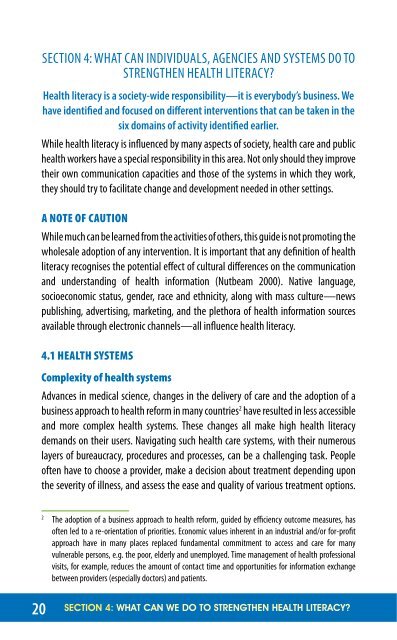Part 1 'the basics' - World Health Communication Associates
Part 1 'the basics' - World Health Communication Associates
Part 1 'the basics' - World Health Communication Associates
Create successful ePaper yourself
Turn your PDF publications into a flip-book with our unique Google optimized e-Paper software.
20<br />
SECTION 4: WHAT CAN INDIVIDUALS, AGENCIES AND SySTEMS DO TO<br />
STRENGTHEN HEALTH LITERACy?<br />
<strong>Health</strong> literacy is a society-wide responsibility—it is everybody’s business. We<br />
have identified and focused on different interventions that can be taken in the<br />
six domains of activity identified earlier.<br />
While health literacy is influenced by many aspects of society, health care and public<br />
health workers have a special responsibility in this area. Not only should they improve<br />
their own communication capacities and those of the systems in which they work,<br />
they should try to facilitate change and development needed in other settings.<br />
a note of caution<br />
While much can be learned from the activities of others, this guide is not promoting the<br />
wholesale adoption of any intervention. It is important that any definition of health<br />
literacy recognises the potential effect of cultural differences on the communication<br />
and understanding of health information (Nutbeam 2000). Native language,<br />
socioeconomic status, gender, race and ethnicity, along with mass culture—news<br />
publishing, advertising, marketing, and the plethora of health information sources<br />
available through electronic channels—all influence health literacy.<br />
4.1 health systems<br />
complexity of health systems<br />
Advances in medical science, changes in the delivery of care and the adoption of a<br />
business approach to health reform in many countries2 have resulted in less accessible<br />
and more complex health systems. These changes all make high health literacy<br />
demands on their users. Navigating such health care systems, with their numerous<br />
layers of bureaucracy, procedures and processes, can be a challenging task. People<br />
often have to choose a provider, make a decision about treatment depending upon<br />
the severity of illness, and assess the ease and quality of various treatment options.<br />
2 The adoption of a business approach to health reform, guided by efficiency outcome measures, has<br />
often led to a re-orientation of priorities. Economic values inherent in an industrial and/or for-profit<br />
approach have in many places replaced fundamental commitment to access and care for many<br />
vulnerable persons, e.g. the poor, elderly and unemployed. Time management of health professional<br />
visits, for example, reduces the amount of contact time and opportunities for information exchange<br />
between providers (especially doctors) and patients.<br />
Section 4: wHat can we do to StrenGtHen HealtH literacy?






